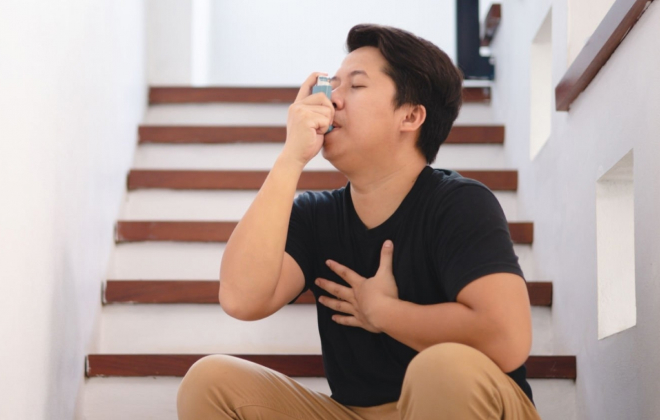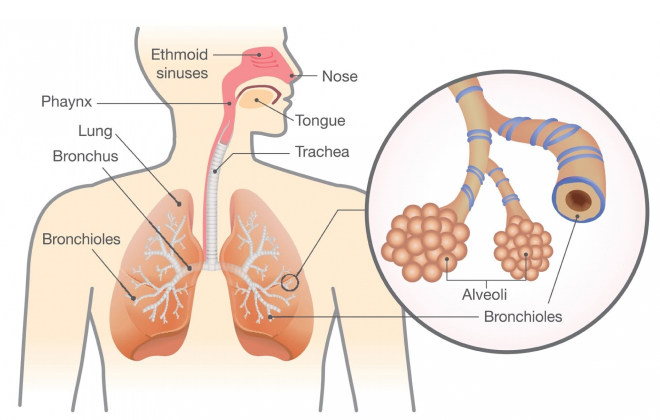


Our respiratory system does one of the most important functions for us – taking in oxygen and getting rid of carbon dioxide, thus helping all our organs function properly. Breathing in harmful pollutants such as smoke or chemicals, can damage our lungs and lead to various respiratory problems such as asthma or chronic bronchitis. Hence keeping a tab on our respiratory health is extremely important.
Regular exercise and staying away from smoking or secondhand smoke can go a long way in preventing such issues. It is also essential to be aware of any symptoms such as persistent coughing, wheezing, or shortness of breath, as these could indicate underlying lung problems. Catching them early on allows us to seek appropriate treatment and maintain optimal respiratory health.
Respiratory conditions can emerge out of the blue and can affect our daily life. Even a minor cough and cold can leave us congested and irritated, finally affecting our mood.

Here are some of the most common respiratory-system related illnesses:
Understanding the anatomy of the respiratory system can shed some light on how this whole process works. Let’s break it down for you.
The respiratory system consists of two main parts: the upper respiratory tract and the lower respiratory tract. The upper respiratory tract consists of our nose, mouth, pharynx (throat), and larynx (or voice box). These structures help us take in air and provide a passageway for it to move further down into our lungs.
The main organ of the lower respiratory tract is the lungs. They are nestled safely in our chest cavity. Surrounding each lung are pleural membranes that help protect and support them. Another important organ in the lower respiratory tract is our bronchial tubes which branch out from our trachea (windpipe) like a tree’s limbs to allow air to flow deep into every corner of our lungs where oxygen is transferred into blood vessels for distribution throughout the body.

When it comes to respiratory health, several factors can have a significant impact. It’s important to be aware of these factors and take necessary precautions such as quitting smoking, avoiding polluted areas whenever possible, and maintaining a healthy weight through regular exercise and proper nutrition for optimal respiratory health.
First and foremost is smoking or exposure to secondhand smoke – one of the leading causes of respiratory diseases such as chronic obstructive pulmonary disease (COPD) and lung cancer.
Additionally, air pollution plays a major role in respiratory health, especially in densely populated areas with high levels of industrial emissions or traffic congestion. Dust, pollen, mould spores, and pet dander can also trigger allergies and asthma attacks in individuals with sensitivities.
Moreover, lifestyle choices such as lack of physical activity, poor diet leading to obesity, and excessive alcohol consumption also contribute to respiratory problems by weakening the immune system and reducing lung capacity.

Regular exercise is not just important for maintaining overall health and fitness; it also plays a crucial role in improving respiratory function. Engaging in physical activity is important. Cardiovascular exercises such as running or aerobic activities such as swimming help to strengthen the muscles involved in breathing, namely the diaphragm and intercostal muscles.
Regular exercise enhances lung capacity and efficiency, allowing more oxygen to be taken in with each breath and facilitating the removal of carbon dioxide from the body. Moreover, physical exertion leads to an increase in heart rate and blood circulation, which aids in delivering oxygen-rich blood throughout the body. These benefits combine to improve respiratory function by reducing shortness of breath during daily activities and increasing endurance levels during exercise.
When it comes to lung health, nutrition plays a crucial role in supporting and maintaining healthy lungs. Just like other organs in our body, our lungs require a variety of nutrients to function optimally.
So next time you think about your lung health, make sure to incorporate these nutritional elements into your daily diet.

If you want to keep your lungs healthy and avoid respiratory irritants and pollutants, there are a few simple steps you can take.
One of the first things you should do is identify potential sources of allergens and irritants in your environment. These may include dust mites, pet dander, mould, pollen, cigarette smoke, or strong chemicals. By keeping your living spaces clean and well-ventilated, you can reduce exposure to these substances.
Additionally, investing in an air purifier with a HEPA filter can help trap airborne particles and improve indoor air quality. When it comes to outdoor activities, pay attention to air quality alerts and try to limit your time outside during days with high pollution levels.
Finally, adopting healthy habits such as regular exercise, proper hydration, and avoiding smoking or secondhand smoke also play a crucial role in maintaining good respiratory health. By being aware of these potential triggers and taking proactive measures to avoid them, you’ll be able to breathe easier and enjoy better overall well-being.
Smoking has a significant and detrimental impact on respiratory health, with consequences ranging from short-term difficulties such as coughing and wheezing to long-term conditions such as chronic bronchitis and emphysema. The chemicals present in cigarettes irritate the airways, leading to inflammation and narrowing of the bronchial tubes.

Over time, this causes irreversible damage to lung tissue, impairs lung function, and increases the risk of developing respiratory infections. However, quitting smoking can dramatically improve respiratory health and reverse some of the damage caused by smoking.
Quitting strategies include using nicotine replacement therapy, undergoing counselling sessions or support groups, and opting for prescription medications. Additionally, adopting a healthy lifestyle with regular exercise and a balanced diet can further boost lung function recovery after quitting smoking.
Taking these steps not only improves one’s respiratory health but also reduces exposure to secondhand smoke for others around them.
Certain breathing techniques can help you in two ways – by increasing your lung capacity and by making you feel relaxed:

So, we all know how annoying and miserable it is to deal with respiratory infections like colds and flu. Here are some tips that can help prevent you catching the flu during the “flu season”.
Regular check-ups with a healthcare professional are way more important than we often realise. Sure, we all know that it’s good to get our annual physical checkups or flu shots, but there is so much more to it than just ticking boxes on some health checklist. These check-ups give us the chance to catch any potential issues early on before they become big problems. It’s like that old saying – prevention is better than cure.
And let us not forget about the peace of mind that comes with knowing you’re taking care of yourself. Plus, your healthcare provider can offer personalised advice on nutrition, exercise, and lifestyle choices that could really make a positive impact on your overall well-being. So don’t take the regular check-ups lightly and go for them regularly.
Prioritising our respiratory health is vital for our overall well-being and quality of life. Throughout this piece, we have explored various key points that highlight the importance of taking care of our lungs.

Maintaining your respiratory health can help prevent respiratory illnesses such as asthma and chronic obstructive pulmonary disease (COPD). Smoking is one of the leading causes of lung-related issues, hence it is better to avoid it or quit altogether.
Avoid exposure to passive smoking as well. Regular exercise and a healthy diet are essential pillars in supporting optimal lung function and having a good respiratory system.
Finally, minimising environmental pollutants and practising proper hygiene reduces the risk of respiratory infections. By implementing these strategies into our daily lives, we can safeguard our lungs, enhance their longevity, and ultimately lead a healthier and happier life. Remember, your lungs deserve the utmost care – so why not focus on your respiratory health today?
Sources
Spread the love, follow us on our social media channels